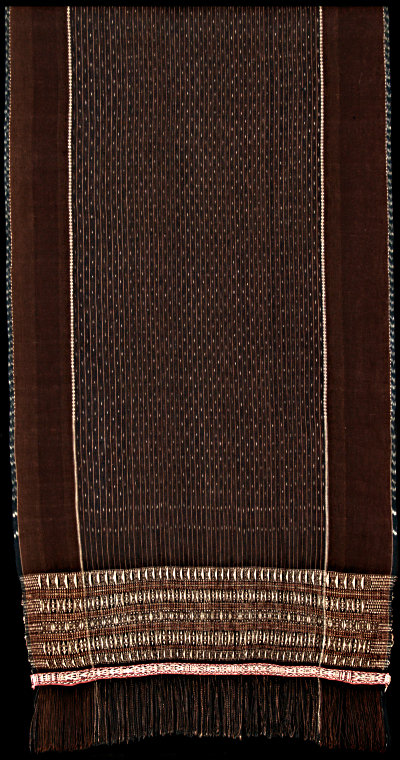| |
 
 | | | |
257 Sumatra, Batak
Ulos (shawl)  
| | Locale: | Toba Batak, probably from region South of Lake Toba. | | Period: | 19th c. | | Yarn: | Cotton, hand-spun, fine | | Technique: | Warp ikat, supplementary weft and supplementary warp | | Panels: | 1 | | Size: | 85 x 230 cm (2' 9" x 7' 6") LW: 2.71 | | Weight: | 480 g (16.9 oz), 246 g/m2 (0.81 oz/ft2) | | Design: | Parallel rows of ikated stipples, gatip, the characteristic pattern for ulos ragi hotan. Narrow ikated stripes adorn the selvedges. Complex supplementary weft patterning in the two ulu, the end fields. Such elaborate ulu no doubt served to increase the value of the cloth, as in nearly all societies major investments in time and creativity are rewarded with both prestige and monetary value. Stripes embellished with warp floats mark the boundaries between the sides and the central field of the cloth, as well as the boundaries between the ikated selvedges and the side panels. Indigo weft. | | Comment: | Ulos ragi hotang, one of the highest ranking cloths in the Batak hierarchy of shawls. An example of unusually generous proportions, a further indicator of great age. The textiles of the past tended to be much larger than the more recent ones. Wide bands of supplementary weft of great intricacy that differ from one another, one being male, the other female. Which end is male, which female may be impossible to decipher even for expert outsiders. Essential at most ceremonies, at weddings ragi hotang would be presented by a bride's clan to the groom. One tiny tear, less than 2cm, in the direction of the warp hence hardly visibly, otherwise in immaculate condition. About two thirds of the cloth shown. Ex collection August Flick. | | Background: | Chapters on Sumatra and Batak. | | Exhibited: | Hong Kong University Museum and Art Gallery, 2017. | | Published: | Ikat Textiles of the Indonesian Archipelago, 2018.
| | Compare: | 057 146 174 217 249 | | Sources: | Near-identical late 19th c. example in Barnes and Hunt Kahlenberg, Five Centuries of Indonesian Textiles, p. 116/117. Near identical, though smaller and presumably younger example in Niessen, Legacy in Cloth, Fig. Cat 4.2f. Both have end fields in supplementary weft with five main bands. | | |

©Peter ten Hoopen, 2025
All rights reserved.
|
|


